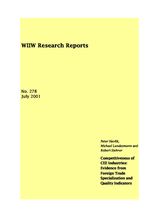Competitiveness of CEE Industries: Evidence From Foreign Trade Specialization and Quality Indicators
Peter Havlik, Michael Landesmann and Robert Stehrer
wiiw Research Report No. 278, July 2001
58 pages including 20 Tables and 24 Figures
This paper analyses the competitiveness of the manufacturing industry in the CEE candidate countries (Bulgaria, the Czech Republic, Estonia, Hungary, Latvia, Lithuania, Poland, Romania, Slovakia and Slovenia) with special emphasis on trade with the European Union during the second half of the 1990s. Changing specialization patterns, the evolution of sectoral trade balances and market shares, as well as price/quality gaps at detailed product level, are used as indicators of trade competitiveness.
The CEE candidate countries' market share in extra-EU manufacturing imports grew from 9.5% in 1995 to 11.4% in 1999, the EU export surplus in manufacturing trade is diminishing. Candidate countries' exports to the EU have been increasingly specialized on a few key industries: textiles and textile products, basic metals and fabricated metal products, electrical & optical equipment and transport equipment; in the Baltic states also on wood and wood products. The manufacturing industry in Slovakia features the highest number of branches with a trade surplus while the weakest competitive position in trade with the EU has been identified for the manufacturing industry in Slovenia, Poland and Latvia. Textiles, wood products, basic metals and furniture were identified as branches where candidate countries enjoy revealed comparative advantages (RCAs) in trade with the EU. Apart from chemicals, rubber and plastic products, nearly all candidate countries show negative RCAs also in pulp and paper, machinery and equipment n.e.c. and electrical and optical equipment.
Technology-driven industries account for a growing share of exports in nearly all candidate countries, labour-intensive industries have growing export shares in Bulgaria, Romania and the Baltic states. The representation of labour-intensive industries in candidate countries' exports to the EU is still - with the notable exception of Hungary - much bigger than in the present EU member states; the representation of technology-driven industries in candidate countries' exports to the EU is usually smaller (Hungary, the Czech Republic, Estonia and Slovakia are exceptions). Nevertheless, the initial export specialization pattern of CEE candidate countries has nearly completely reversed: in many candidate countries export specialization is evolving towards more sophisticated and less capital-intensive industries. Labour-intensive industries accounted for a major part of competitive export gains in Bulgaria, Latvia, Lithuania and Romania.
Finally, using very detailed information on export unit prices, an analysis of the 'quality' of candidate countries' export products shows that there were substantial price gaps between CEE producers and EU incumbents over the 1990s. However, some countries have closed these gaps (Hungary and Slovenia in particular), while others maintain very substantial price gaps (Bulgaria and Romania in particular). The largest price/quality gaps are found in 'technology-driven' and 'mainstream' industries, as well as in 'high-skill-intensive branches'; the lowest price gaps in capital-intensive and low-skill-intensive branches. Over time, however, the strongest 'quality catching-up' can be observed in 'technology-driven' and 'high-skill-intensive' industries. Again, Hungary occupies the position of an 'outlier' amongst the candidate countries, especially with regard to 'quality catching-up' in the 'technology-driven' and skill-intensive industries.
Keywords: EU candidate countries, competitiveness, trade specialization, catching-up, structural and technological change
JEL classification: F14, F15, L6, P27
Countries covered: Bulgaria, Czechia, Estonia, Hungary, Latvia, Lithuania, Poland, Romania, Slovakia, Slovenia, Baltic States, SEE, Visegrad countries
Research Areas: International Trade, Competitiveness and FDI, Sectoral studies
